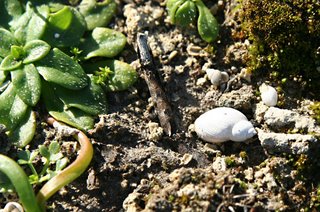 What Australia lacks in snail diversity, it makes up for in its large number of short-range endemics. They’re everywhere. Well, in small bits of everywhere. The country is chockers with species whose entire range might be a single gorge in central Australia, a cliff face in the Ningbing Ranges or a mound spring in the Simpson Desert. Species whose existence depends on a few hundred square metres of habitat.
What Australia lacks in snail diversity, it makes up for in its large number of short-range endemics. They’re everywhere. Well, in small bits of everywhere. The country is chockers with species whose entire range might be a single gorge in central Australia, a cliff face in the Ningbing Ranges or a mound spring in the Simpson Desert. Species whose existence depends on a few hundred square metres of habitat. That’s Austroassiminea letha in the picture. No, not the big one. That’s Glyptophysa. The weeny thing to the north. Although common as fossils in Pleistocene soils between Cape Leeuwin and Point D’Entrecasteaux, living Austroassiminea letha are restricted to just a few spots near the coast. Plot them out on a map and the linear range is about 40 km. Not that small, then. But the snails are so strict in their requirements—suitable freshwater seeps only occur on limestone or at the junction of limestone and underlying igneous rock—that they are found in only four localities along the 40 km line. Three of them are clustered around Augusta. The other one is near Margaret River.
Austroassiminea is unusual for a number of reasons. First off, it’s a monotypic genus—it contains a single species. Okay, that’s more interesting than odd. But what is a bit weird is that it’s one of only two non-marine assimineids found on mainland Australia.
Two things are wrapped up that statement. The first is that most assimineids in Australia live in marine and brackish-water habitats. Whereas elsewhere the family has escaped the sea with great enthusiasm, few of them have made that transition here. Only two genera have shifted out—Duritropis on Norfolk Island and Opinorelia on Lord Howe Island. Both live on land. Why haven't more made the break?
The second oddity is that, worldwide, very few assimineids live in freshwater habitats. Of those, the best known are Eussoia of eastern Africa from Somalia to Mozambique; Pseudogibbula in the Zaire River; and Solenomphala from damp habitats on stream banks in China, Taiwan and Japan. That’s not an impressive list. But mainland Australia has two non-marine assimineids and both of them are monotypic freshwater genera.
The second one is Aviassiminea palitans. (I don’t have a picture but it looks very similar to the first.) Aviassiminea palitans is widespread in northern Australia from the Pilbara in Western Australia to Mataranka in the Northern Territory. Like Austroassiminea letha, it lives along edges of seeps and springs. But, although it belongs to the same family, it is not closely related to Austroassiminea. So the freshwater habit has evolved twice in Australian non-marine assimineids. Odd, eh?
Read more
Fukuda, H. & Ponder, W.F. (2003). Australian freshwater assimineids, with a synopsis of the Recent genus-group taxa of the Assimineidae (Mollusca: Caenogastropoda: Rissooidea). Journal of Natural History 37: 1977–2032.
Solem, A, Girardi, E-L., Slack-Smith, S. & Kendrick, G.W. (1982). Austroassiminea letha, gen. nov. sp. nov, a rare and endangered prosobranch snail from south-western Australia (Mollusca: Prosobranchia: Assimineidae). Journal of the Royal Society of Western Australia 65: 119–129.